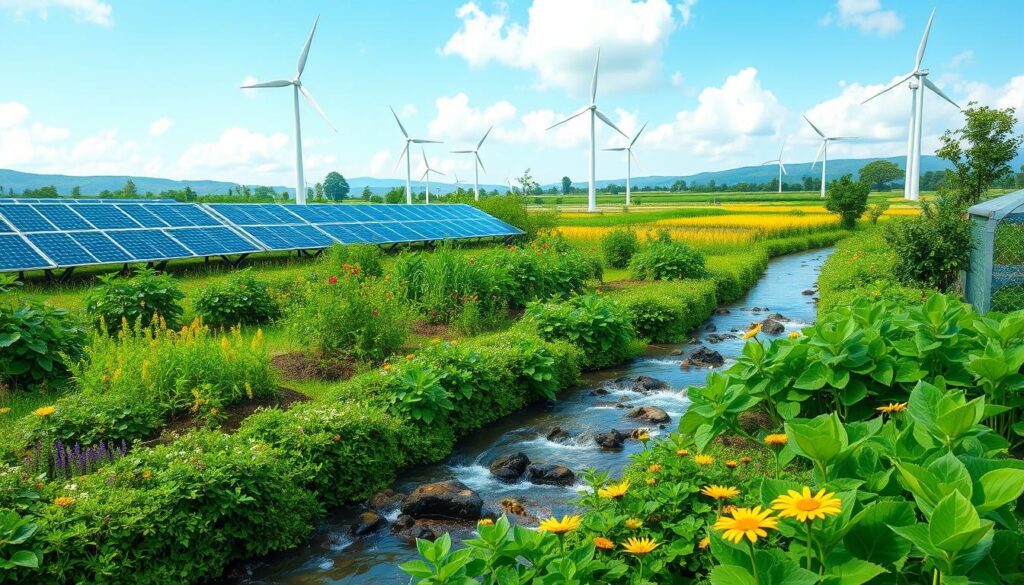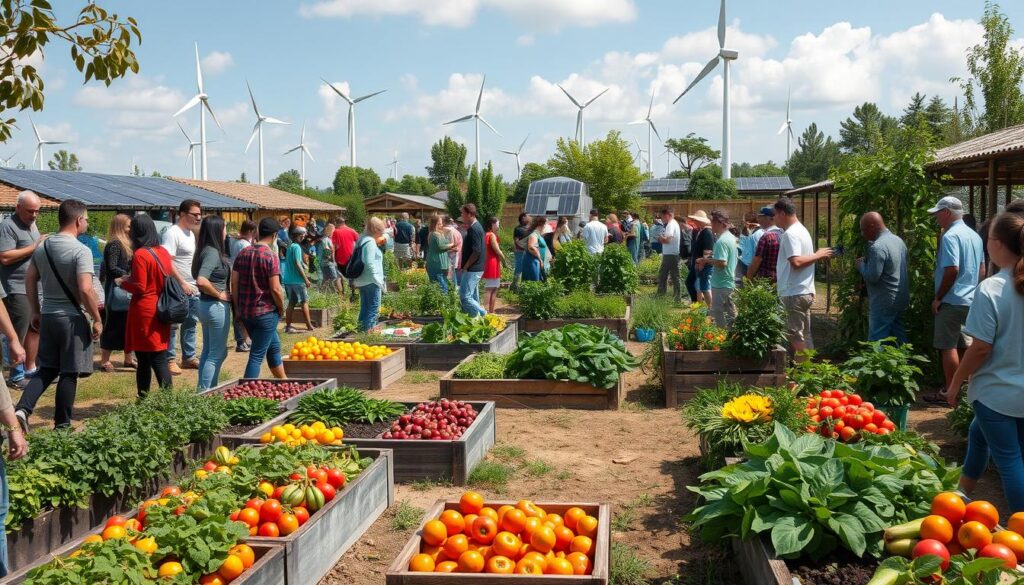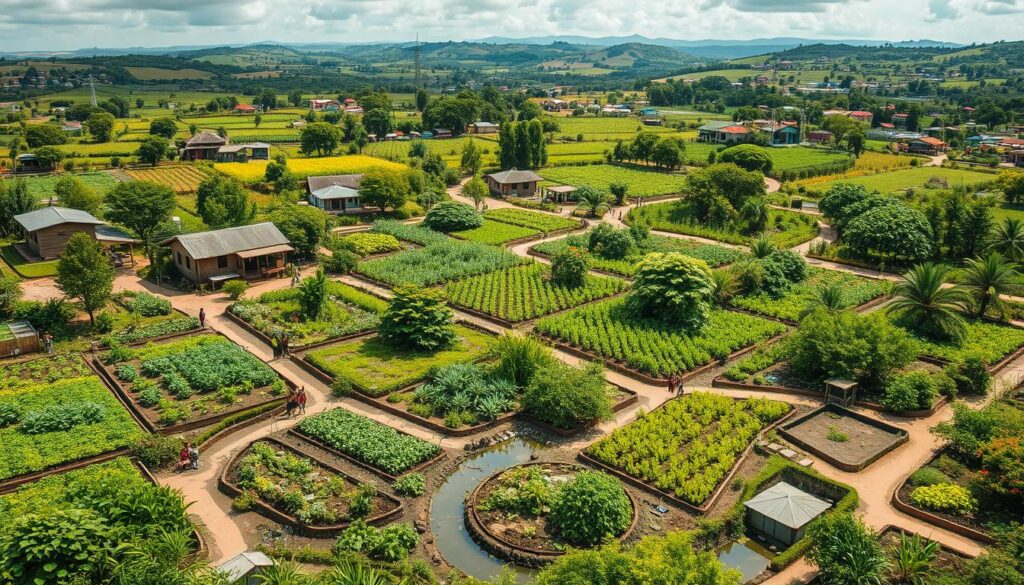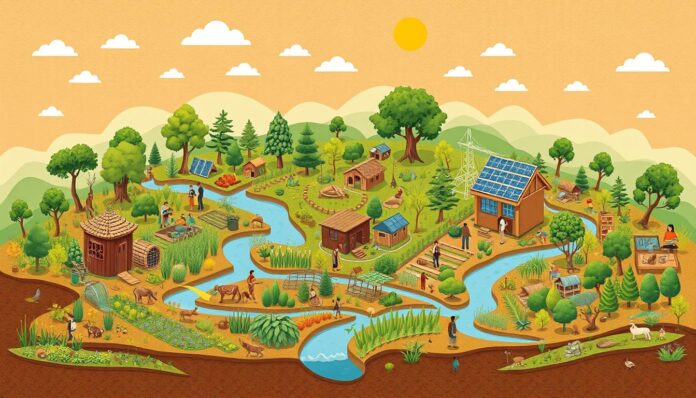Five billion people struggle with the high cost of basic needs. This shows we need permaculture economy systems that focus on sustainability. Permaculture finance is a solution that involves local planning and community. It aims to build a stronger economy.
The permaculture flower has seven petals. It guides us in designing a better economy. It covers land care, building design, tools, culture, health, finances, and community.
Permaculture economic systems can lead to a more sustainable life. Knowing permaculture finance is key to financial freedom. By using permaculture in finance, we can break free from harmful economies.
The idea of “obtaining a yield” is important in permaculture and achieving financial freedom. Discussions have linked permaculture’s twelve principles to personal finance. This shows how permaculture can help us gain financial independence.
Key Takeaways
- Permaculture economy systems prioritize sustainability and regenerative economics
- Permaculture finance emphasizes local planning and community involvement
- The permaculture flower provides a framework for designing a permaculture economy
- Permaculture principles can be applied to personal finance to achieve financial autonomy
- The concept of “obtaining a yield” is a key theme in permaculture and FI/RE
- Permaculture economic systems have the potential to create a more sustainable and fulfilling life
Introduction to Permaculture Economic Systems
Permaculture is a design system for sustainable living. It can be used in economics to create new systems. These systems focus on local planning and community involvement. One example is permaculture mutual credit, which lets communities trade without money.
Community currency is also linked to permaculture economics. It’s a special money for a certain area, helping local businesses grow. This way, people support local shops instead of big companies.
Understanding Permaculture Principles
Permaculture has three main ethics: care for the earth, care for people, and future care. These ethics help us live sustainably and lessen our environmental impact. In economics, they guide us to build systems that are good for both people and the planet.
The Role of Economics in Permaculture
Economics is key in permaculture, helping us understand how resources move. By using permaculture in economics, we can build better, more sustainable systems. For instance, permaculture mutual credit and community currency help local economies grow and reduce our need for traditional money.
| System | Description |
|---|---|
| Permaculture Mutual Credit | A system that allows communities to exchange goods and services without using traditional currency |
| Community Currency | A type of currency that is specific to a particular region or community, used to promote local economic development |
| Alternative Economy | An economic system that prioritizes sustainability and community involvement, often using permaculture principles |
The Basics of Economic Systems in Permaculture
Permaculture economic systems focus on being sustainable and eco-friendly. They aim to benefit both people and the planet. A key part of these systems is the local exchange trading system (LETS). It lets people trade goods and services without using money.
At the core of permaculture economics is sustainable finance. It’s about managing money in a way that’s good for the environment and fair for everyone. This idea sees economic activity as connected to nature. It aims to build a more regenerative and strong economy.
Some key parts of a permaculture economic system include:
- Local food systems
- Renewable energy sources
- Sustainable agriculture practices
- Community-based initiatives

By following these principles, permaculture economic systems can create a better finance framework. This framework supports the long-term health of both people and the planet. As more people seek sustainable and regenerative practices, the value of local exchange trading system (LETS) and other alternative economic models will keep growing.
| Element | Description |
|---|---|
| Local Food Systems | Supporting local farmers and food producers to promote sustainable agriculture |
| Renewable Energy Sources | Investing in solar, wind, and other renewable energy sources to reduce dependence on fossil fuels |
| Sustainable Agriculture Practices | Implementing practices that minimize harm to the environment and promote soil health |
| Community-Based Initiatives | Supporting local community projects and initiatives that promote social and environmental well-being |
Different Types of Economic Systems
Exploring permaculture means understanding different economic systems. Regenerative economics supports sustainable practices and fights environmental harm. Traditional models, on the other hand, often focus on profit, causing harm.
Traditional vs. Modern Economic Models
Modern models, like the alternative economy, aim for fairness and care for the planet. They value local planning and community help. LIFT Economy and its founders, Erin Axelrod and Kevin Bayuk, are great examples.
Circular Economy and Its Relevance to Permaculture
A circular economy works to cut waste and reuse resources. It matches well with permaculture’s goal of a self-sustaining system. Using a mutual credit system helps in exchanging goods and services, building cooperation.
Key aspects of a regenerative economy include:
- Focus on local and sustainable practices
- Encouraging community involvement and cooperation
- Adopting alternative economic models, like mutual credit systems
- Reducing waste and promoting recycling and reuse
By embracing these principles, we can build a stronger, more sustainable economy. This economy will support permaculture and help both people and the planet.
| Economic System | Key Features | Benefits |
|---|---|---|
| Regenerative Economics | Local and sustainable practices, community involvement, alternative economic models | Promotes sustainability, reduces waste, fosters cooperation |
| Alternative Economy | Emphasis on social and environmental consciousness, mutual credit systems | Creates a more equitable system, supports local communities, reduces environmental degradation |
The Importance of Sustainability in Economics
Sustainability is key in economics. It makes sure economic actions don’t hurt the environment or use up natural resources too fast. In permaculture economy systems, this is done by working with nature, not against it. This way, we support eco-friendly and sustainable finance, which helps the economy grow over time.
Understanding sustainability in economics is vital. It means an economy can keep working well for a long time without hurting future generations. This idea ties closely to permaculture systems, which aim to create ecosystems that are self-sustaining and produce plenty while wasting little.

Unsustainable practices can cause big problems like environmental damage, social unfairness, and economic troubles. But, using sustainable finance and eco-friendly practices can help grow the economy, ensure fairness, and protect the environment. By using permaculture systems and sustainable finance, we can help make the economy better for everyone and the planet.
Experts say permaculture is a complete way to look at economics. It sees how social, economic, and environmental systems are all connected. By adopting this view, we can build a stronger, more sustainable economy that helps both people and the planet.
Designing an Effective Permaculture Economy
Creating a good permaculture economy needs careful thought. It’s about using regenerative economics to build a strong local economy. By following permaculture principles, we can make a system that lasts and is strong.
Using community currency is a big part of it. It keeps money in the local area, helping us be self-sufficient. By being green and using less waste, we help the planet and support our local economy.
Core Design Principles
Some key ideas for a good permaculture economy are:
- Encouraging local production and consumption
- Promoting renewable energy and reducing waste
- Supporting community involvement and participation
Implementing Sustainable Practices
It’s important to use green practices for a strong permaculture economy. This means using less of what’s not renewable, keeping nature diverse, and backing local food. By focusing on permaculture finance and regenerative economics, we build a lasting economy. This supports our community and the planet.
Community-Based Economic Approaches
Community-based economic approaches are key to a sustainable and resilient economy. They focus on local involvement and mutual support. The alternative economy highlights the value of local exchange and community growth.
A mutual credit system is a core part of these approaches. It lets people and businesses trade without money. The local exchange trading system (LETS) also plays a role, helping communities create their own currency.

These methods bring many benefits. They boost local economic activity, foster social bonds, and cut down on external reliance. By embracing these strategies, communities can build a stronger, more sustainable economy for all.
Some key advantages include:
- Increased local economic activity
- Improved social cohesion
- Reduced reliance on external systems
By working together and supporting local economic development, communities can create a brighter future for themselves and future generations.
Resources and Tools for Permaculture Economies
Permaculture economy systems focus on using sustainable and eco-friendly finance. They aim to support environmentally conscious practices. These systems also highlight the need for local planning and community involvement in creating a sustainable economy.
Financial Tools for Sustainable Practices
There are many financial tools that help with sustainable practices in permaculture economies. These include community currencies and crowdfunding platforms. They help people and communities invest in projects that are good for the environment.
Educational Resources and Workshops
Educational resources and workshops are key in teaching about permaculture economy systems and sustainable finance. They give people the knowledge and skills to create and use sustainable economic models.
Some notable resources include:
- Online courses and workshops on permaculture design and sustainable finance
- Community-based initiatives and cooperatives promoting eco-friendly practices
- Research institutions and organizations focused on sustainable economic development
By using these resources and tools, people and communities can support sustainable finance and eco-friendly practices. This helps build a more environmentally conscious and economically strong permaculture economy.
| Resource | Description |
|---|---|
| Permaculture Design Course | A comprehensive online course covering permaculture principles and design |
| Sustainable Finance Workshop | A hands-on workshop focused on sustainable finance practices and eco-friendly investing |
| Community-Based Initiative | A community-led project promoting sustainable development and eco-friendly practices |
The Role of Technology in Permaculture Economics
Technology is key in permaculture economics, helping to build regenerative economics and alternative economy models. It uses new tech like AI and blockchain. This tech helps with crop planning, pest control, and making permaculture more open.
A mutual credit system can be set up online. It makes it easier to trade goods and services locally. This way, we can grow our economies in a green way, without needing old financial systems.
- Improved crop yields and reduced waste
- Enhanced transparency and traceability in permaculture practices
- Increased efficiency and productivity in agricultural operations
- Facilitated knowledge sharing and collaboration among local communities
By using tech and regenerative economics and alternative economy models, we can make local economies better. This helps make the world economy more fair and green.
Regenerative Practices and Economic Resilience
Regenerative practices are key for building economic strength in permaculture finance. They help us use resources wisely and care for our planet. Alan Enzo, a leader in permaculture, says these practices work in many areas like fixing the environment and running businesses in a green way.
Some main ideas of regenerative practices include:
- Efficient use of natural resources
- Restoration of ecological balance
- Promotion of local economic design
- Creation of varied livelihoods for all ages within communities
These ideas help in designing communities and building intentional ones. For instance, the Asheville project, led by Enzo, aims to build a community that supports everyone. It offers jobs for all ages. By using regenerative practices, we can make our economy stronger and help the planet.

B. Lorraine Smith told Brazilian business leaders that a regenerative economy is good for the planet. It captures carbon, brings back biodiversity, and improves life for everyone. Investing in regenerative finance helps us grow in a green way.
| Regenerative Practice | Benefits |
|---|---|
| Efficient use of natural resources | Reduced environmental impact, cost savings |
| Restoration of ecological balance | Improved biodiversity, enhanced ecosystem services |
| Promotion of local economic design | Increased economic resilience, community engagement |
Case Studies: Successful Permaculture Economies
Permaculture economy systems focus on sustainable development and community involvement. They use alternative economy ideas for local planning and mutual support. A key part is the mutual credit system, which lets people exchange goods without money.
Worldwide examples show how well permaculture economies work. For example, community-supported agriculture (CSA) helps farmers earn a steady income. It also makes sure people get fresh, local food. This boosts food security and helps the economy grow in a sustainable way.
Lessons Learned from Successful Models
Successful permaculture economies use a few key strategies:
- Local food production and distribution
- Community currencies and exchange systems
- Cooperative ownership and decision-making
- Educational programs and skill-sharing initiatives
By using these strategies, communities can thrive. They focus on sustainability, fairness, and helping each other. As we move towards more alternative economy models, mutual credit systems and community involvement will become even more important.
| Strategy | Description |
|---|---|
| Local Food Production | Enhances food security and reduces carbon footprint |
| Community Currencies | Encourages local spending and stimulates the local economy |
| Cooperative Ownership | Fosters collaborative decision-making and equitable distribution of resources |
Policy Implications for Permaculture Economies
The world is moving towards more sustainable ways. This change highlights the need for good policies in permaculture economies. Governments can help by supporting regenerative economics and sustainable finance. They can offer incentives for eco-friendly actions and invest in green energy and infrastructure.
It’s important to push for policies that support permaculture. We need to spread the word about eco-friendly finance and sustainable growth. Together, we can build a better future for everyone.

- Investments in renewable energy and sustainable infrastructure
- Incentives for businesses and individuals to adopt eco-friendly practices
- Support for local food systems and sustainable agriculture
By focusing on regenerative economics and sustainable finance, we can make a better future. We must keep pushing for permaculture-friendly policies and support green practices. This will ensure a future we can all live in.
Challenges and Solutions in Permaculture Economics
Permaculture finance and alternative economy models are key for sustainable growth. Starting large-scale farming can be costly. But, a mutual credit system helps by letting farmers trade without money.
Local economies and community involvement are central to permaculture finance. Selling homemade goods and starting small farms are good ways to do this. For instance, a small herb farm in South Wales shows how local farming can be sustainable.
Some benefits of permaculture economics include:
- Soil gets better through methods like polycultures and composting
- Crop diversity makes big permaculture farms less likely to fail
- Niche markets for green produce help farms make money
Using permaculture finance and alternative economies helps farms grow sustainably. This approach cuts costs, boosts yields, and opens up markets for green produce.
| Permaculture Farm | Location | Size |
|---|---|---|
| Beforest Collectives | Various locations | Over 100 acres |
| Poomaale 1.0 Collective | Unknown | Unknown |
Future Trends in Permaculture Economic Systems
The world is moving towards more sustainable and eco-friendly ways. Permaculture economic systems are changing to meet these new needs. The future of permaculture economics is bright, with new practices and innovations focusing on regenerative economics and sustainable finance.
One big trend is eco-friendly finance. This approach puts the environment and social responsibility first. It knows that our economic actions affect the planet. By using eco-friendly finance, we can help make a better future.
Some new practices in permaculture economics include:
- Local currency systems that help local economies grow
- Cooperative ownership models that involve the community
- Sustainable agriculture that lowers environmental harm
For more on permaculture and animal welfare, check out permaculture practice.
The growing role of permaculture in economics shows the value of regenerative economics and sustainable finance. By focusing on the environment and social good, we can build a fairer and greener economy.
| Practice | Benefits |
|---|---|
| Regenerative economics | Promotes environmental sustainability and social responsibility |
| Sustainable finance | Supports eco-friendly practices and reduces environmental impact |
| Eco-friendly finance | Prioritizes environmental sustainability and social responsibility |
Conclusion: The Path Forward
Exploring permaculture economics shows us how vital it is to add sustainable practices to our money management. Permaculture finance teaches us to manage wealth in a way that’s good for both people and the planet. It focuses on being self-sufficient, using resources wisely, and caring for the environment.
By adopting regenerative economics, we can make our economy work better with nature. This approach helps us lessen our harm to the environment and builds stronger communities. It encourages us to work together, share resources, and support each other financially.
Looking ahead, using permaculture in our economy is a chance to change how we think about money and resources. It helps us see how everything is connected. This way, we can create an economy that’s good for everyone and the planet.

